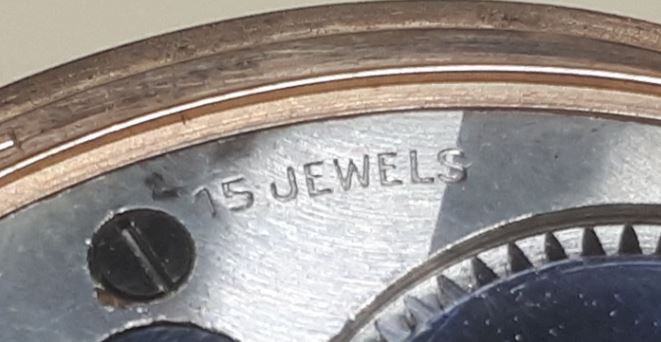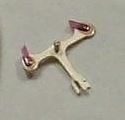Last updated on June 26, 2024
The word jewel conjures up images of elaborate, expensive and exotic gemstones. As a component of a watch movement, the word jewel refers to a relatively inexpensive part of the watch. The jewels are tiny and are not there for decoration. They are an important part of the movement and are critical for long term accurate timekeeping rather than for ornamentation. In fact, you can buy 100 watch jewels on eBay for less than 10 pounds. In a typical, high-quality antique pocket watch movement you will only likely find about 15 of these jewels. At 10p each that only equates to about £1.50 of value.
Jewels as bearings
A jewel in an antique watch movement is there as a bearing. It provides a hard-wearing, low friction pivot point for many of the moving parts in the movement. At some point in ancient horological times, watchmakers discovered that the metal bearings they were using were subject to wear and tear over time. This meant that the bearings eroded over time and that the metal on metal interaction caused friction, which affected accurate timekeeping. The solution was to use jewels, which were much more durable and had lower kinetic friction than metal bearings. This meant they lasted much longer, with less lubrication and kept more accurate time.

The first jewel bearings were invented in 1704 for use in watches by Nicolas Fatio de Duillier, Peter Debaufre, and Jacob Debaufre, who received an English patent for the idea. Originally, only natural jewels were available. As a result, diamonds, sapphires, rubies, and garnets were used. The jewel bearings were created using a labour-intensive process using tools with diamond abrasive components. In 1902, a process to make synthetic sapphire and ruby (crystalline aluminium oxide, also known as corundum) was invented by Auguste Verneuil, making jewelled bearings much cheaper. Today, almost all jewelled bearings are synthetic ruby or sapphire.
The number of jewels
The use of jewel bearings in mechanical watches, where their low and predictable friction improves watch accuracy as well as improving bearing life. Manufacturers traditionally listed the number of jewels prominently on the watch face or stamped on the movement. A typical fully jewelled time-only antique watch has 15 jewels: two cap jewels, two pivot jewels and an impulse jewel for the balance wheel, two pivot jewels and two pallet jewels for the pallet fork, and two pivot jewels each for the escape, fourth and third wheels.

Early antique watches often had much less, sometimes with as few as seven jewels or less. Many manufacturers used the jewel count as a marketing ploy, citing large numbers of jewels for the movement. The fact is, there is a limit to the number of jewels that are beneficial to an antique watch movement. The jewels only offer benefits to the moving parts of which there is a finite number in a watch movement. Sometimes the manufacturers would also only place jewels on the visible parts of the movement, using metal bearings on the hidden parts of the movement.
Types of jewels
There are several different types of jewels that are commonly used in antique watches, these are described below. The actual jewels are only a few millimetres in diameter, and the holes in the jewels are measured in fractions of a millimetre.
Hole jewels
These are tiny doughnut-shaped jewels of synthetic ruby or sapphire, which have a hole in their centre. These are designed as bearings for the wheel arbors. This provides a smooth, hard surface which is also very low friction. This allows the watch to run with less mainspring power and protects the moving parts of the watch from wear.
Cap jewels
Cap jewels are tiny disks, which sit over the hole jewel. In a capped jewel, the wheel pivot will ride on the cap jewel and will be prevented from wandering sideways by the hole jewel. This has the effect of further reducing friction. In theory, capped jewels on the escapement of a watch will provide for more consistent performance in a wider range of positions than just a hole jewel alone.

Pallet jewels
These angle-faced jewels are attached to the pallet fork and interact with the teeth on the escape wheel. There are two pallet jewels, commonly called the entry and exit jewels, which take turns “locking” the gear train of the watch and then transferring impulse power (through the impulse jewel) to the balance.

Impulse jewel
A typical watch has one impulse jewel, which is located on the roller-table of the balance. As the balance turns, the impulse jewel oscillates back and forth, contacting the pallet fork on each swing. This unlocks the pallet, allowing the escape wheel to advance one tooth, thereby regulating the escapement of the watch. The roller-jewel is the single point of contact between the balance and the rest of the gear train.
A 7 jewel watch has jewels located in these positions:
- 1 impulse pin.
- 2 pallets.
- 2 balance staff bearings.
- 2 balance staff capstones.
An 11 jewel watch adds:
- 2 lever bearings.
- 2 escape wheel bearings.
A 15 jewel watch adds:
- 2 fourth wheel bearings.
- 2 third wheel bearings.
A 17 jewel watch adds:
- 2 centre wheel bearings.
A 19 jewel watch adds:
- 2 pallet fork cap jewels.
- Or 2 mainspring barrel jewels.
- Or 2 escape wheel capstones.
A 21 jewel watch adds:
- 2 lever capstones.
- 2 escape wheel capstones.
A 23 jewel watch adds:
- 2 mainspring barrel bearings.
Additional notes
If unmarked, removal of the dial is necessary to inspect the plate jeweling and confirm an accurate jewel count. Many 11-jewel movements are jewelled only on the top plate without corresponding jewels on the pillar plate.
Some manufacturers produced 16-jewel movements that can easily be mistaken for 17-jewels. These movements have a hole jewel for the centre wheel on the top plate, but do not contain a corresponding jewel on the pillar plate. The removal of the dial is usually required to determine the accurate count unless the plate is marked with the jewel count. Typically, if the centre hole is jewelled and the movement is not marked with jewel count, it is likely to be a 16-jewel movement.
Considerations for collecting
Generally, as a collector, you should be targeting quality antique pocket watches with at least 15 jewels. However, there are sure to be many collectable timepieces that perhaps may only have 7 jewels. Unless the antique watch has a number of complications anything beyond 23 jewels is unnecessary. If you are looking for an antique pocket watch that will be useable and reliable, look for pieces with a higher jewel count.
A list of additional posts regarding antique watches can be found on the Guides page.

Thank you for the explanations given, opened a whole new world to me
Hi David, glad to be of assistance, this post has a few more details about antique watch components. Thanks for commenting, Jason